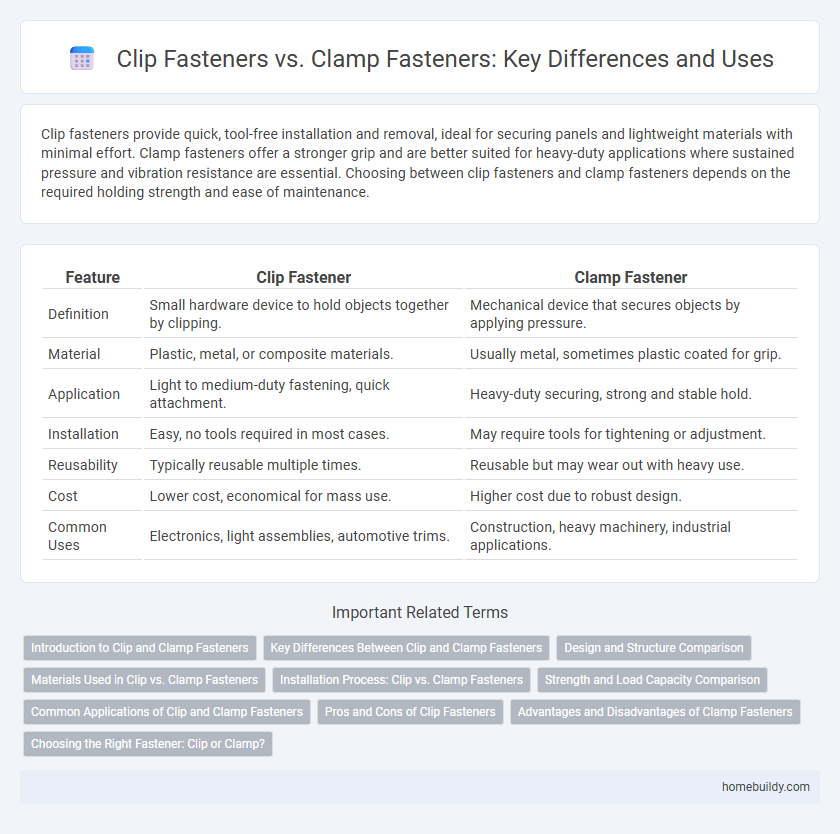Clip fasteners provide quick, tool-free installation and removal, ideal for securing panels and lightweight materials with minimal effort. Clamp fasteners offer a stronger grip and are better suited for heavy-duty applications where sustained pressure and vibration resistance are essential. Choosing between clip fasteners and clamp fasteners depends on the required holding strength and ease of maintenance.
Table of Comparison
| Feature | Clip Fastener | Clamp Fastener |
|---|---|---|
| Definition | Small hardware device to hold objects together by clipping. | Mechanical device that secures objects by applying pressure. |
| Material | Plastic, metal, or composite materials. | Usually metal, sometimes plastic coated for grip. |
| Application | Light to medium-duty fastening, quick attachment. | Heavy-duty securing, strong and stable hold. |
| Installation | Easy, no tools required in most cases. | May require tools for tightening or adjustment. |
| Reusability | Typically reusable multiple times. | Reusable but may wear out with heavy use. |
| Cost | Lower cost, economical for mass use. | Higher cost due to robust design. |
| Common Uses | Electronics, light assemblies, automotive trims. | Construction, heavy machinery, industrial applications. |
Introduction to Clip and Clamp Fasteners
Clip fasteners are versatile mechanical devices designed to securely hold components together through snapping or clipping actions, often used in automotive and electronic assemblies for quick and reliable fastening. Clamp fasteners provide adjustable pressure by tightening around objects, commonly employed in plumbing, construction, and manufacturing to ensure firm and stable connections. Both clip and clamp fasteners offer distinct advantages in fastening applications, balancing ease of use, strength, and reusability.
Key Differences Between Clip and Clamp Fasteners
Clip fasteners provide quick attachment and removal by snapping into place using spring tension, ideal for lightweight materials. Clamp fasteners secure components through compressive force by tightening screws or bolts, offering stronger and more reliable holds for heavy-duty applications. The primary difference lies in clip fasteners' ease of use and speed versus clamp fasteners' superior strength and durability in demanding environments.
Design and Structure Comparison
Clip fasteners feature a flexible, spring-like design that allows quick attachment and removal, often incorporating hooks or barbs to grip surfaces securely. Clamp fasteners utilize a rigid, hinged structure with a tightening mechanism such as screws or levers to firmly hold objects together, providing higher clamping force and stability. The clip's lightweight, snap-fit construction favors applications requiring frequent adjustment, while the clamp's robust frame suits heavy-duty fastening tasks.
Materials Used in Clip vs. Clamp Fasteners
Clip fasteners are commonly made from spring steel or stainless steel to provide flexibility and corrosion resistance, suitable for securing panels or trim without permanent deformation. Clamp fasteners often utilize aluminum alloys or heavy-duty steel for increased strength and durability, designed to maintain high clamping force under dynamic loads. The material choice directly impacts fastener performance, with clips favoring elasticity and clamps prioritizing strength and rigidity.
Installation Process: Clip vs. Clamp Fasteners
Clip fasteners typically require a simple snap-in installation, allowing them to securely attach to panels or components without the need for tools, which significantly reduces labor time. Clamp fasteners often involve tightening screws or bolts to firmly hold parts together, offering a more adjustable and durable connection but requiring more precision and time during assembly. The clip fastener installation process favors speed and ease, while clamp fasteners emphasize strength and reliability for heavier-duty applications.
Strength and Load Capacity Comparison
Clip fasteners generally offer moderate strength and are designed for lightweight applications, providing sufficient load capacity for securing thin materials or components. Clamp fasteners exhibit higher strength and superior load capacity, making them suitable for heavy-duty or industrial uses where robust fastening and resistance to shear forces are critical. The load capacity of clamp fasteners can exceed clip fasteners by up to 50%, enabling them to maintain structural integrity under greater mechanical stress.
Common Applications of Clip and Clamp Fasteners
Clip fasteners are commonly used in automotive trim assembly, electronic enclosures, and panel mounting due to their quick installation and secure hold on lightweight materials. Clamp fasteners find widespread application in hose and pipe connections, cable management systems, and heavy machinery where robust, adjustable securing is required. Both fasteners offer reliable solutions tailored to specific load and environmental conditions in industrial and consumer products.
Pros and Cons of Clip Fasteners
Clip fasteners offer quick installation and removal, making them ideal for temporary or adjustable connections in automotive and industrial applications. They provide excellent vibration resistance and flexibility but may lack the clamping strength and durability of clamp fasteners under heavy loads or extreme environmental conditions. Their convenience in assembly is counterbalanced by potential susceptibility to loosening over time compared to more robust clamp fasteners.
Advantages and Disadvantages of Clamp Fasteners
Clamp fasteners offer superior holding power and are ideal for securing heavy or irregularly shaped components, providing excellent vibration resistance and ease of reuse. However, they tend to be bulkier and more expensive than clip fasteners, requiring additional installation time and specialized tools. Their robust design enhances durability but can limit applicability in tight spaces or lightweight assemblies compared to clip fasteners.
Choosing the Right Fastener: Clip or Clamp?
Clip fasteners provide quick installation and removal with secure holding for lightweight materials, making them ideal for applications requiring frequent adjustments. Clamp fasteners offer stronger, more durable grip for heavy-duty tasks and high-stress environments, ensuring long-term stability. Selecting between clip and clamp fasteners depends on load requirements, material type, and the nature of the assembly process.
Clip Fastener vs Clamp Fastener Infographic

 homebuildy.com
homebuildy.com